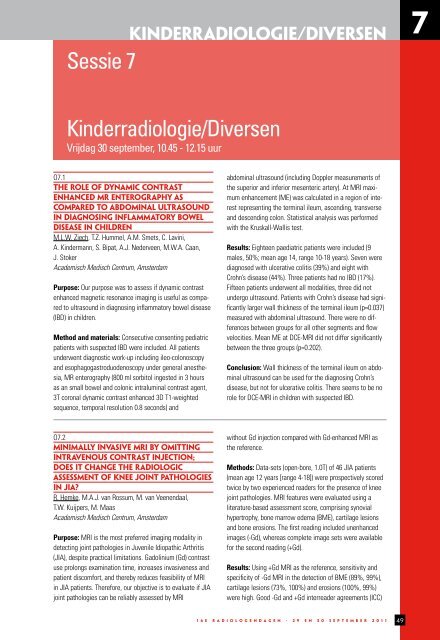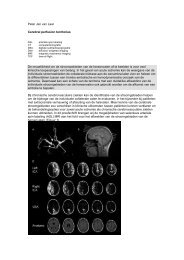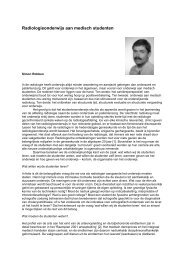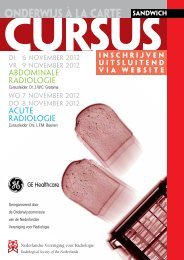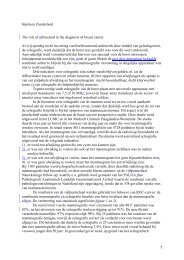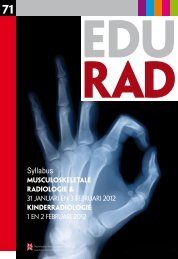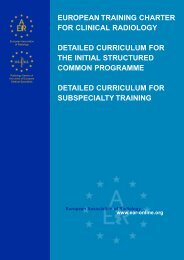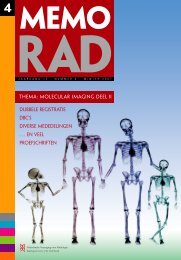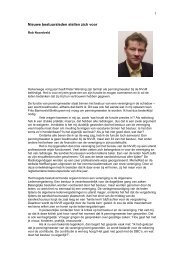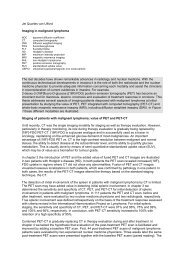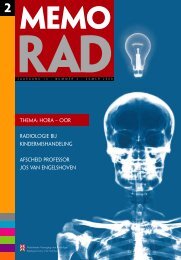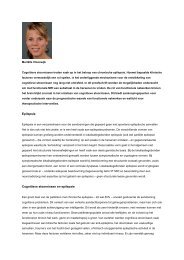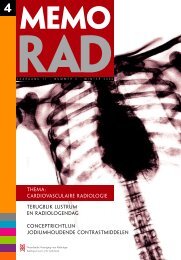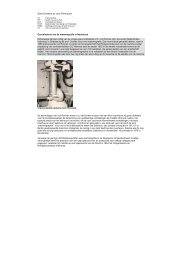programma & abstracts - Nederlandse Vereniging voor Radiologie
programma & abstracts - Nederlandse Vereniging voor Radiologie
programma & abstracts - Nederlandse Vereniging voor Radiologie
You also want an ePaper? Increase the reach of your titles
YUMPU automatically turns print PDFs into web optimized ePapers that Google loves.
Sessie 7<br />
Kinderradiologie/Diversen 7<br />
Kinderradiologie/Diversen<br />
Vrijdag 30 september, 10.45 - 12.15 uur<br />
O7.1<br />
THE ROLE OF DYNAMIC CONTRAST<br />
ENHANCED MR ENTEROGRAPHY AS<br />
COMPARED TO ABDOMINAL ULTRASOUND<br />
IN DIAGNOSING INFLAMMATORY BOWEL<br />
DISEASE IN CHILDREN<br />
M.L.W. Ziech, T.Z. Hummel, A.M. Smets, C. Lavini,<br />
A. Kindermann, S. Bipat, A.J. Nederveen, M.W.A. Caan,<br />
J. Stoker<br />
Academisch Medisch Centrum, Amsterdam<br />
Purpose: Our purpose was to assess if dynamic contrast<br />
enhanced magnetic resonance imaging is useful as compared<br />
to ultrasound in diagnosing inflammatory bowel disease<br />
(IBD) in children.<br />
Method and materials: Consecutive consenting pediatric<br />
patients with suspected IBD were included. All patients<br />
underwent diagnostic work-up including ileo-colonoscopy<br />
and esophagogastroduodenoscopy under general anesthesia,<br />
MR enterography (800 ml sorbitol ingested in 3 hours<br />
as an small bowel and colonic intraluminal contrast agent,<br />
3T coronal dynamic contrast enhanced 3D T1-weighted<br />
sequence, temporal resolution 0.8 seconds) and<br />
abdominal ultrasound (including Doppler measurements of<br />
the superior and inferior mesenteric artery). At MRI maximum<br />
enhancement (ME) was calculated in a region of interest<br />
representing the terminal ileum, ascending, transverse<br />
and descending colon. Statistical analysis was performed<br />
with the Kruskall-Wallis test.<br />
Results: Eighteen paediatric patients were included (9<br />
males, 50%; mean age 14, range 10-18 years). Seven were<br />
diagnosed with ulcerative colitis (39%) and eight with<br />
Crohn’s disease (44%). Three patients had no IBD (17%).<br />
Fifteen patients underwent all modalities, three did not<br />
undergo ultrasound. Patients with Crohn’s disease had significantly<br />
larger wall thickness of the terminal ileum (p=0.037)<br />
measured with abdominal ultrasound. There were no differences<br />
between groups for all other segments and flow<br />
velocities. Mean ME at DCE-MRI did not differ significantly<br />
between the three groups (p=0.202).<br />
Conclusion: Wall thickness of the terminal ileum on abdominal<br />
ultrasound can be used for the diagnosing Crohn’s<br />
disease, but not for ulcerative colitis. There seems to be no<br />
role for DCE-MRI in children with suspected IBD.<br />
O7.2<br />
MINIMALLY INVASIVE MRI BY OMITTING<br />
INTRAVENOUS CONTRAST INJECTION;<br />
DOES IT CHANGE THE RADIOLOGIC<br />
ASSESSMENT OF KNEE JOINT PATHOLOGIES<br />
IN JIA?<br />
R. Hemke, M.A.J. van Rossum, M. van Veenendaal,<br />
T.W. Kuijpers, M. Maas<br />
Academisch Medisch Centrum, Amsterdam<br />
Purpose: MRI is the most preferred imaging modality in<br />
detecting joint pathologies in Juvenile Idiopathic Arthritis<br />
(JIA), despite practical limitations. Gadolinium (Gd) contrast<br />
use prolongs examination time, increases invasiveness and<br />
patient discomfort, and thereby reduces feasibility of MRI<br />
in JIA patients. Therefore, our objective is to evaluate if JIA<br />
joint pathologies can be reliably assessed by MRI<br />
without Gd injection compared with Gd-enhanced MRI as<br />
the reference.<br />
Methods: Data-sets (open-bore, 1.0T) of 46 JIA patients<br />
(mean age 12 years [range 4-18]) were prospectively scored<br />
twice by two experienced readers for the presence of knee<br />
joint pathologies. MRI features were evaluated using a<br />
literature-based assessment score, comprising synovial<br />
hypertrophy, bone marrow edema (BME), cartilage lesions<br />
and bone erosions. The first reading included unenhanced<br />
images (-Gd), whereas complete image sets were available<br />
for the second reading (+Gd).<br />
Results: Using +Gd MRI as the reference, sensitivity and<br />
specificity of -Gd MRI in the detection of BME (89%, 99%),<br />
cartilage lesions (73%, 100%) and erosions (100%, 99%)<br />
were high. Good -Gd and +Gd interreader agreements (ICC)<br />
1 6 E R A D I O L O G E N D A G E N - 2 9 e n 3 0 S E P T E M B E R 2 0 1 1<br />
49


